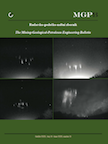An geological overview of glacial accumulation and erosional occurrences at the Velebit and the Biokovo Mts., Croatia
DOI:
https://doi.org/10.17794/rgn.2017.4.8Abstract
Numerous accumulation and erosional forms originating from the activity of small valley glaciers or cirque glaciers occur in the highest mountains in Croatia: Velebit (1757 m) and Biokovo (1762 m). They were produced during the Upper Pleistocene, in the Würm glacial stage of the Alpine classification.
Accumulation forms comprise ground, terminal and recessional moraines, drumlins, eskers, glacial erratics and glaciofluvial and glaciolacustrine sediments. Single ridge eskers are often associated with areas of kame and kettle topography. Among erosional occurrences roche moutonnée (sheepback rocks), U-shaped valleys ranging in size from meso-macro, arêtes, hanging valleys, meso-sized cirques, kettles, and striations were noted. In Croatian Dinarides such forms in most cases occur between 900 and 1400 meters altitude. During the early to middle Würm glacial maximum, the snow line was above 900 m, perhaps even above 1000 m altitude, and sea levels were 120 meters lower than at present day. Considering the features of the present relief, ice cover was probably 200 to 300 m thick. Features of drumlins, eskers and kettles point to warm-based glaciers. The drumlins are small – up to 100 meters long and 50 meters wide, with the most common long axis ranging orientation from 130o – 310o. The near total absence of platy clasts, as well as their stratigraphic affiliation, largely reflects features of source rocks.
Downloads
Published
How to Cite
Issue
Section
License
Copyright (c) 2017 Rudarsko-geološko-naftni zbornik

This work is licensed under a Creative Commons Attribution 4.0 International License.
Creative Commons-BY
Authors who publish with this journal agree to the following terms:
In agreeing this form, you certify that:
- You read the ethical codex of the RGN zbornik available at journal web.
- You submitted work is your original work, and has not previously been published and does not include any form of plagiarism.
- You own copyright in the submitted work, and are therefore permitted to assign the licence to publish to RGN zbornik.
- Your submitted work contains no violation of any existing copyright or other third party right or any material of an obscene, libellous or otherwise unlawful nature.
- You have obtained permission for and acknowledged the source of any illustrations, diagrams or other material included in the work of which you are not the copyright owner.
- You have taken due care to ensure the accuracy of the work, and that, to the best of your knowledge, there are no false statements made within it.
- All co-authors of this submitted work are aware of, and in agreement with, the terms of this licence and that the submitted manuscript has been approved by these authors.
Publication licence
You retain copyright in your submitted work, according to journal license policy (CC-BY). By signing this form you agree that RGN zbornik may publish it under the publication licence. In summary the licence allows the following:
Anyone is free:
- To copy, distribute, display, and perform the work.
- To make derivative works.
Under the following conditions:
- The original author must always be given credit.
- The work may not be used for commercial purposes.
- If the work is altered, transformed, or built upon, the resulting work may only be distributed under a licence identical to this one.
Exceptions to the licence
In addition to publishing the work printed under the above licence, RGN zbornik will also enable the work to be visible online.
The journal editorial can change the licence rules anytime but it cannot retroactively restrict author(s) rights.


